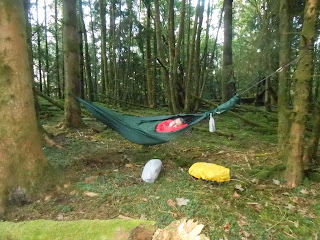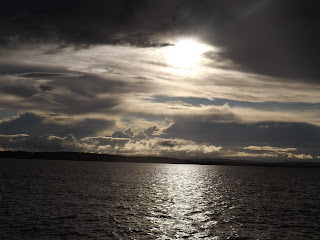
Way back last June I wrote a blog post about the John Muir Award I was doing on my Scottish highlands trip in April. At the time I wrote it, I was intending to follow it up quite quickly, but unfortunately I got distracted. That post looked at who John Muir was and why he was important. This one will talk about what I actually did on my trip. I'll be trying to link it in with the John Muir award's conservation theme throughout.
Abernethy forest is one of the most amazing places I've ever visited. It feels ancient, mysterious and very, very alive. Red Squirrels dance around the base of twisting Scots Pines, White-faced Darters dart around bog pools and Golden-ringed Dragonflies race down forest rides. Ospreys soar overhead. It's a lot more open and light than the forest plantations I'm used to in Northumberland, with its twisting trees and heather and bilberry under canopy.
I've camped there twice now, the first time in a tent, the second in my hammock. It's one of those places that really shows you the advantages of hammock camping, as you don't have to worry about tree roots, spiky pine cones or uneven ground. My favourite spot is on the north bank of Loch Mallachie, which I've shared with a family of Goldeneye and some Common Sandpipers. Sandpipers make for noisy neighbours!
Wild camping is legal across most of Scotland, but it's very important that campers behave responsibly. Being in one of the few remaining fragments of the old Caledonian forest, I avoided having any open fires, just using my camping stove and even then placing it on top of a large boulder that became my combination chair and table. I also made sure I took any rubbish away with me, and buried any human waste well away from water sources.
The basic principle I always like to stick to is to leave the place looking like I'd never been there at all. That seems to cover all of the bases. With a tent, it's important to move it every few days to allow the ground beneath it to recover. That's probably less critical with a hammock, but I tend to move every day or so anyway. The beauty of wild camping is that it lets you move from place to place at a steady pace, though it's also nice to be able to leave most of your heavier equipment in one place while you go chasing dragonflies in the bog pools.
Abernethy is an important site for Capercaille. The RSPB do great Caper-watch events each spring, and they encourage people to come to these to try and see lekking Capercaille, rather than seeking them out themselves which can disturb them. Sleeping in the forest made it easier to get there for 5am, and a helpful Tawny Owl acted as my alarm clock, getting me up in plenty of time. I was eventually rewarded with an excellent view of a displaying male.
A lot of the Scottish specialities can be seen from hides, a great way of getting close to wildlife while minimizing disturbance. Speyside Wildlife run dusk trips to a fantastic hide near Aviemore, where I got incredibly close to my first ever Pine Martens and Badgers.
They do put food out to encourage the animals. I discussed this with the guide, and he explained that they are careful about the quantities they leave, doing everything they can to ensure the animals don't become dependent on them as a food source.
After the highlands, I went up to the Black Isle, where I stayed with a family friend for a few days. She put me in touch with a friend of hers, who runs Ecoventures, in Cromarty, and I arranged a boat trip with them into the Cromarty Firth, where I got to see dolphins, Long-tailed Ducks and nesting auks.
Ecoventures are part of the Dolphin Space Programme, an accreditation scheme that ensures that the dolphins aren't bothered or hassled by boat trip operators. They'll often come very close in to boats of their own accord, but shouldn't be followed as that can put them off feeding and end up being quite dangerous. Programmes like the DSP are a really good way to ensure that any guides and tour operators you use are putting the interests of the animals first.
The Scottish highlands are a truly special place, for watching wildlife and for getting back to nature. Taking a little care of what you do will help to ensure that they are still there to go back to, again and again.
The clearest way into the Universe is through a forest wilderness.
- John Muir.




































